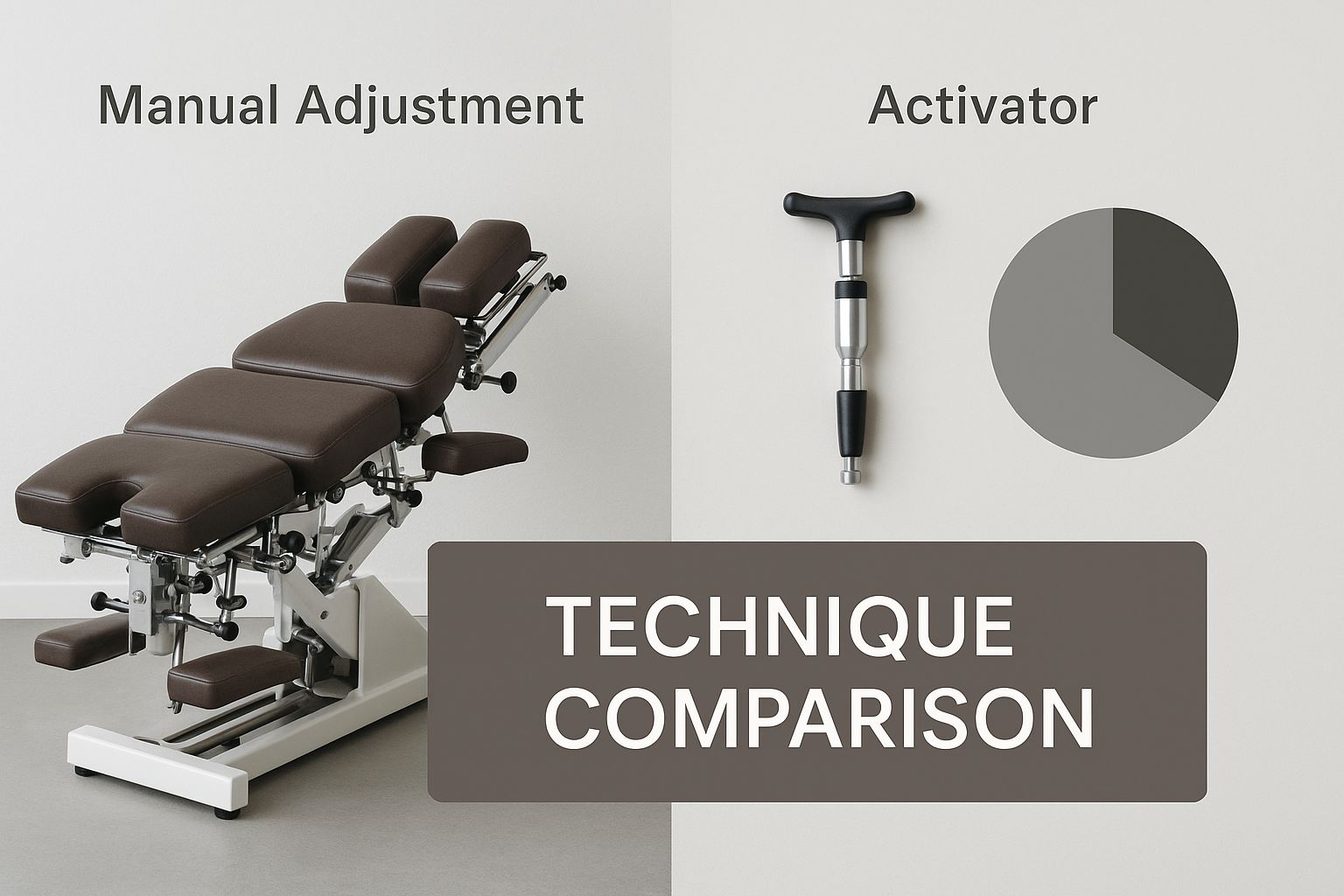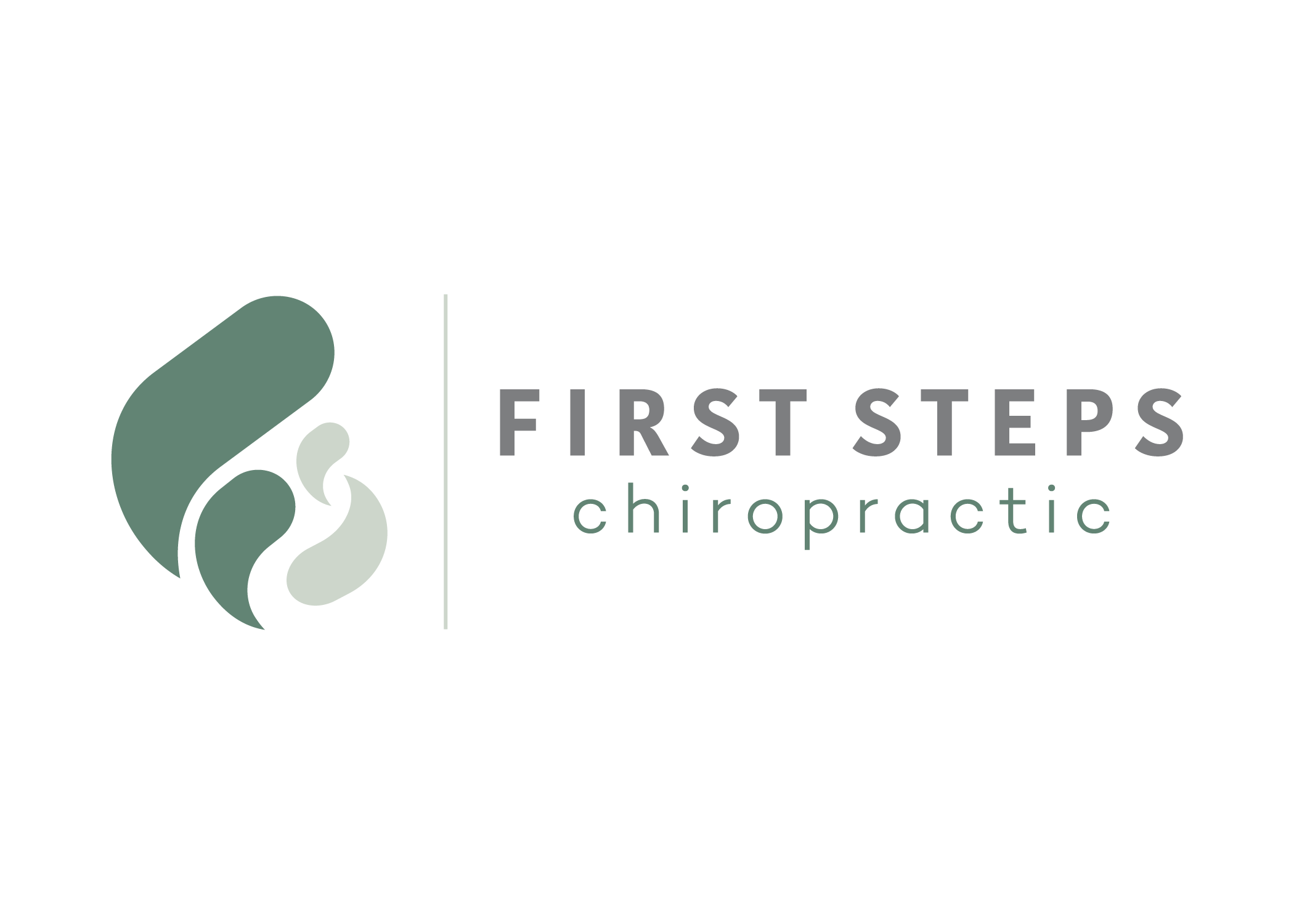Chiropractic care is all about supporting the health of your nervous system by correcting spinal misalignments that mess with nerve communication. Think of it like clearing the static from a phone line. An adjustment helps restore that clean, crisp connection between your brain and the rest of your body, allowing everything to function the way it's supposed to. This essential relationship is the entire basis for the synergy between chiropractic and the nervous system.
Understanding Your Nervous System: The Body's Master Control
To really get why chiropractic works, you first have to appreciate the nervous system itself. Picture your body as a massive, bustling city. Your nervous system is the complex electrical grid and communication network that runs the whole show, making sure every light turns on, every factory is productive, and every single message gets delivered instantly and correctly.
Your brain is the central power plant, generating the signals that control every single function—from your heartbeat to your thoughts. The spinal cord is the main transmission line, a superhighway of information protected by your spine. Branching off this highway are countless nerves, the wires that connect to every last home and building (your organs, muscles, and cells).
For this "city" to truly thrive, the flow of information has to be seamless. A clear signal is absolutely vital for health, healing, and everyday function.
The Central Nervous System: The Mainframe
The Central Nervous System (CNS) is made up of the brain and spinal cord. It’s the mainframe computer, processing all the information coming in from your environment and sending out commands. It governs the things you consciously do, like walking and talking, but it also handles the automatic processes you never even think about. When the CNS is working well, your body can adapt, heal, and perform at its peak.
"The nervous system controls and coordinates all the functions of the body and relates it to its environment." – Gray's Anatomy, 29th Edition.
This really drives home just how critical clear communication is. Any disruption along that spinal superhighway can create ripple effects throughout your entire body. We can actually see how this system is functioning with advanced tools, which you can learn about in our guide on Insight Scans for the nervous system.
The Autonomic Nervous System: The Automatic Pilot
Branching off the CNS is the Autonomic Nervous System (ANS), which acts as your body's automatic pilot. It handles all the background tasks you never have to consciously manage. The ANS is divided into two parts that are meant to work in perfect harmony.
-
Sympathetic Nervous System (Fight or Flight): This is your body's gas pedal. It kicks in during times of stress, danger, or even excitement. It revs up your heart rate, sharpens your focus, and gets your body ready for immediate action.
-
Parasympathetic Nervous System (Rest and Digest): This is the brake pedal. It takes over when you're safe and relaxed, helping you digest food, conserve energy, and kickstart the healing and recovery processes.
The problem with modern life is that chronic stress often keeps that "gas pedal" floored. This prevents our bodies from shifting into the crucial "rest and digest" state needed for repair and rejuvenation. Grasping this balance is key to understanding how chiropractic adjustments can help regulate the nervous system, guiding your body back toward a state of calm and resilience. This basic knowledge is the foundation for understanding how even small spinal issues can create big disruptions.
How Spinal Misalignments Disrupt Nerve Communication

Think of your nervous system as your body's intricate electrical grid. If that’s the case, a spinal misalignment—what chiropractors call a vertebral subluxation—is a major roadblock on the main power line. It’s not just about a bone being slightly out of place; it's a real source of physiological interference that messes with the critical flow of information between your brain and every part of your body.
Here’s a simple analogy: imagine a garden hose with a kink in it. Sure, water still gets through, but the flow is weak and inconsistent. That's a great way to picture what happens to nerve signals when a vertebra gets stuck or misaligned.
The physical pressure and inflammation that build up around that misaligned joint can irritate the delicate nerves passing through, essentially creating "static on the line." This distortion means messages from the brain don't get delivered with the clarity and speed your body needs to function, heal, and adapt to its environment.
Where Does the Interference Come From?
When a spinal joint loses its proper motion, it creates both mechanical and chemical stress on the nervous system. This isn't just a theory; it's a tangible problem that can kick off a cascade of issues.
The nerve irritation can stem from a few places:
- Direct Mechanical Pressure: The misaligned bone can physically press on or rub against the nerve root as it exits the spine.
- Inflammatory Response: A dysfunctional joint triggers inflammation, which releases chemicals that sensitize and irritate the surrounding nerve tissue.
- Altered Joint Motion: A joint that isn't moving right sends garbled "movement data" back to the brain, which can confuse the central nervous system over time.
This constant flood of distorted information forces the brain to work overtime just to make sense of what’s happening. Eventually, this can lock you into that chronic state of stress—that "fight or flight" mode we talked about earlier.
A vertebral subluxation acts as a physical stressor, creating a persistent, low-grade emergency signal within the nervous system. This disruption prevents the body from fully entering a state of rest, recovery, and healing.
Real-World Examples of Nerve Disruption
This isn't some abstract idea. It has real-world consequences that many people live with every day, often without ever realizing the root cause could be in their spine. The location of the misalignment usually gives us clues about the symptoms that might show up.
For instance, a subluxation in the upper neck (cervical spine) can interfere with nerves connected to the head, sinuses, and even the brainstem. This can show up as persistent tension headaches or migraines, as the brain struggles to interpret the scrambled signals it’s getting. It’s like trying to have a clear phone conversation with terrible reception.
Similarly, a misalignment in the lower back (lumbar spine) can impact the huge sciatic nerve. This can lead to the pain, numbness, or tingling that travels down the leg, a well-known condition called sciatica. The signal from the brain telling the leg how to move and what to feel is being physically compromised on its journey.
The connection between chiropractic and the nervous system is so direct that modern diagnostic tools can actually measure these changes. We can see chiropractic care's influence through measurable shifts in things like heart rate variability (HRV) and skin temperature patterns. Advanced infrared thermography, for example, can show us these thermal patterns. A healthy nervous system typically displays symmetrical heat distribution, while chronic subluxations often create fixed asymmetries, pointing directly to autonomic dysfunction. You can dive deeper into the research on measuring nervous system performance with these methods.
This fundamental link between spinal structure and neurological function is precisely what chiropractic care is designed to address. By identifying and correcting these misalignments, a chiropractor’s goal is to remove the interference and restore the integrity of your body's most important communication network.
Chiropractic Adjustments: Restoring Your Body's Master Control System
When your spine is misaligned, it's like having a traffic jam on your body's information superhighway—the nervous system. A chiropractic adjustment isn't just about getting a "crack" or "pop"; it's a highly specific procedure designed to clear those roadblocks. The real goal is to restore proper motion to your spinal joints, which in turn removes the interference bogging down your nerve signals.
Think of your nervous system as a sophisticated Wi-Fi network. A spinal misalignment, or subluxation, is like a faulty router creating lag, dropped signals, and poor performance across the board. The chiropractic adjustment is the careful reboot that brings back a clear, strong signal, allowing information to flow freely and instantly between your brain and every part of your body.
At its core, this process is all about improving communication. When a chiropractor adjusts a joint, it does more than just move a bone—it sends a powerful wave of positive feedback from the body straight to the brain. This flood of new sensory data from the now-mobile joint helps the central nervous system recalibrate its own patterns and hit the reset button.
The Science Behind the Adjustment
Every adjustment is a direct conversation with your nervous system. By applying a specific, gentle force to a restricted joint, a chiropractor stimulates specialized nerve endings called mechanoreceptors. These tiny receptors are tasked with sensing movement and position, and waking them up sends a rush of afferent input—that’s information traveling to the brain—up the spinal cord.
This fresh sensory information essentially overrides the old, static-filled signals that were coming from the stuck joint. The brain receives this clear message and can finally get back to work reorganizing muscle control, dialing down inflammation, and normalizing nerve function in that area. It's a direct intervention aimed at improving how the brain perceives and controls the body.
This neurological reset isn't just a theory; modern research is increasingly showing us just how much adjustments impact brain function. For instance, studies using brain imaging have revealed that chiropractic care can directly alter how the central nervous system processes pain. A notable 2019 pilot study showed that spinal adjustments changed brain activity related to pain perception. This suggests the adjustment isn't just masking a symptom—it’s changing how the brain interprets pain signals at the source. You can read more about the study's findings on brain function to see the data for yourself.
Modern Techniques for Gentle Correction
The old image of a forceful "back cracking" is long outdated. Today's chiropractors use a wide range of gentle and precise techniques, all designed to communicate with the nervous system as effectively as possible. We have numerous tools in our toolbox, allowing us to customize care for everyone from newborns to seniors.

As the image shows, modern chiropractic care includes both hands-on adjustments and instrument-assisted techniques, giving us the flexibility to choose the best approach for each individual's body and needs.
Here are a few common methods you might encounter:
- Manual Adjustments: The classic technique where the chiropractor uses their hands to apply a controlled, gentle thrust to a specific joint.
- Instrument-Assisted Adjustments: Tools like the Activator or Torque Release Technique (TRT) deliver a very light, fast, and precise impulse to the spine. These are fantastic options for infants, children, or anyone who prefers a lower-force approach.
- Table-Assisted Adjustments: We use specialized tables with sections that gently drop away, using gravity to assist the adjustment for a comfortable and highly effective correction.
This table helps illustrate the fundamental difference between chiropractic care and conventional methods that primarily target symptoms.
Chiropractic Adjustment vs Conventional Pain Management
| Aspect | Chiropractic Adjustment | Conventional Pain Management (e.g., Medication) |
|---|---|---|
| Primary Target | The nervous system and spinal joint function. | The symptom of pain itself (e.g., nerve endings, inflammation). |
| Mechanism of Action | Restores proper joint motion to remove nerve interference, improving brain-body communication. | Blocks pain signals, reduces inflammation, or alters chemical pain pathways. |
| Primary Goal | Correct the root cause of dysfunction to enhance the body's self-healing ability. | Manage or mask symptoms to provide temporary relief. |
| Approach | Holistic; treats the body as an integrated system. | Symptom-focused; addresses the area of pain or discomfort. |
Ultimately, the two approaches operate on different philosophies. Chiropractic seeks to improve the body's innate function, while conventional pain management aims to interrupt the pain signal.
The purpose of every adjustment, regardless of the technique used, is to restore the integrity of the communication link between your brain and body. It's about optimizing function, not just silencing symptoms.
In the end, the powerful link between chiropractic and the nervous system is all about creating balance. By restoring proper motion in the spine, chiropractic adjustments help calm an overstressed nervous system. This allows your body to shift out of a constant "fight or flight" mode and back into a state of rest, healing, and optimal function.
The Neurological Impact of Chiropractic Care

We've talked about the mechanics of an adjustment, but let's get into the measurable, science-backed results. The effects of chiropractic care on the nervous system aren't just theoretical—they create real, tangible improvements in how your body works, from muscle control right down to how you manage stress. These physiological changes show how an adjustment is so much more than a simple fix for pain.
When your nerve signals can flow freely without interference, your brain and body can communicate much more effectively. Think of it like upgrading your body’s internal software for faster, more accurate processing. This stronger connection leads to better muscle control, quicker reaction times, and a noticeable boost in physical performance.
This direct link is exactly why so many athletes depend on chiropractic care. They aren't just trying to get relief from injuries; they are actively working to optimize their nervous system for peak performance. After all, a clear neural pathway is the foundation for strength, speed, and precision.
Boosting Strength and Performance
One of the most immediate and well-documented benefits of chiropractic care is its direct impact on neuromuscular function. In fact, research has shown that even a single spinal adjustment can lead to significant increases in muscle strength. This isn't magic—it happens because the adjustment helps the brain activate your muscles more completely.
Imagine your brain sending a signal to a muscle, telling it to contract. If a spinal misalignment is creating static on the line, that signal arrives weakened or incomplete. As a result, the muscle simply can't fire at its full potential. By clearing that interference, chiropractic adjustments allow for a stronger, clearer signal, which translates directly into greater muscle output.
Multiple studies have demonstrated this effect across different groups of people. For instance, researchers have documented notable increases in quadriceps muscle strength in college students, improved maximal voluntary contraction in athletes, and even enhanced muscle strength in chronic stroke patients after just one chiropractic session. You can dig into the specifics by reading the research on potential spinal manipulation effects.
This is a core principle in functional neurology, a field dedicated to improving brain and nervous system function without drugs or surgery. Strengthening this brain-body link is central to achieving better health, which you can learn more about by exploring the role of functional neurology in chiropractic care.
Enhancing Your Body's Stress Resilience
Beyond just muscle function, chiropractic adjustments have a profound impact on the autonomic nervous system (ANS)—the very system that controls your stress response. One of the best ways to measure your body's ability to handle stress is through a metric called Heart Rate Variability (HRV).
HRV measures the tiny variations in time between each heartbeat. A high HRV is a great sign; it indicates a healthy, adaptable nervous system that can easily switch between "fight or flight" mode (sympathetic) and "rest and digest" mode (parasympathetic). On the other hand, a low HRV suggests your body is stuck in a state of stress, making it less resilient to life's challenges.
A higher Heart Rate Variability (HRV) is a direct indicator of a well-balanced nervous system. It shows that your body is adaptable, resilient, and ready to recover from physical, chemical, and emotional stressors.
Spinal misalignments can act as a constant physical stressor, often locking the body into that "fight or flight" state and driving down HRV. By correcting these misalignments, chiropractic adjustments help calm the nervous system, allowing the body to shift back toward a parasympathetic state where healing and recovery can happen.
Studies have confirmed that a course of chiropractic care can lead to significant improvements in HRV. This means adjustments do more than just make your back feel better; they fundamentally improve your body's ability to adapt to and recover from stress.
The implications for your overall health are huge:
- Better Sleep: A calmer nervous system is key to promoting deeper, more restorative sleep cycles.
- Improved Mood: Shifting out of "fight or flight" can help ease feelings of anxiety and overwhelm.
- Enhanced Recovery: The parasympathetic state is when your body gets to work repairing tissues and recovering from the day's activities.
By focusing on the body's master control system, the connection between chiropractic and the nervous system offers a path to not only resolve symptoms but to build a more resilient, better-functioning body from the inside out.
Whole-Body Wellness Through a Healthy Nervous System
While most people walk into a chiropractor’s office for the first time because of nagging back or neck pain, the benefits we see often go far beyond the spine. The real magic happens when we support the nervous system. When this master control system can do its job without interference, the positive effects can ripple through your entire body, touching everything from your sleep quality to your immune response.
Think about it—your nervous system coordinates every single function in your body. By restoring a clear line of communication between your brain and the rest of you, chiropractic adjustments can help regulate processes you might not immediately connect to your spine. A calmer, better-regulated nervous system is truly the foundation for genuine, whole-body wellness.
Better Sleep and Digestion Through Nerve Regulation
Two of the most common "surprise" improvements patients report are better sleep and smoother digestion. This connection makes perfect sense once you look at the brainstem, which is protected by the upper part of your neck. The brainstem is a critical hub that helps manage core functions like your sleep-wake cycles, breathing, and heart rate.
When the vertebrae in the upper neck are misaligned, they can create irritation and stress right at this vital control center. That interference can throw the delicate balance of your autonomic nervous system out of whack, often keeping your body stuck in a state of high alert.
By gently adjusting the upper cervical spine, we can reduce this neurological stress. This simple act helps your body shift more easily out of "fight or flight" and into its "rest and digest" mode.
- For Sleep: A calmer nervous system paves the way for deeper, more restorative sleep cycles, so you can actually wake up feeling refreshed.
- For Digestion: This "rest and digest" state is absolutely essential for proper digestive function, like producing enzymes and ensuring things move along as they should.
When your nervous system is balanced, your body can finally dedicate the right resources to these crucial background processes.
A healthy nervous system acts like a skilled conductor, ensuring every section of your body's orchestra plays in perfect harmony. When the communication is clear, systems like digestion, sleep, and immunity can perform at their best.
Bolstering Your Immune Response
Your nervous system and immune system are in constant conversation. It’s a complex relationship where the health of one directly impacts the other. We know that chronic stress—often fueled by nervous system dysfunction—is notorious for suppressing immune function, leaving you more vulnerable to getting sick.
When your body is locked in that sympathetic "fight or flight" state, it prioritizes immediate survival over long-term projects like fighting off a virus. It’s a survival mechanism that diverts resources away from your immune defenses.
Chiropractic adjustments help break this pattern by easing the physical stress on your nervous system. By encouraging that shift toward the parasympathetic "rest and digest" state, adjustments help your body move out of crisis mode and back into a state of maintenance and healing. This allows your immune system to function more effectively, ready to protect you as it's designed to. The connection between chiropractic and the nervous system is therefore a key piece of the puzzle in building natural resilience.
This shift is crucial for your overall health. To dive deeper into supporting this calming part of your body, check out our guide on parasympathetic nervous system stimulation. By addressing the root cause of nerve interference, chiropractic care offers a path to not only feeling better but to functioning better on a deep, physiological level.
Your Questions on Chiropractic and The Nervous System Answered
Now that we’ve explored the deep connection between your spine and your body's master control system, you probably have a few questions. That's completely normal. Let's dig into some of the most common curiosities people have about how chiropractic care actually supports and improves the nervous system in practice.
How Can a Chiropractor Tell If My Nervous System Is Affected by My Spine?
This is where science meets the art of chiropractic. We use specific diagnostic tools that go way beyond a simple physical exam to get a clear, objective picture of your neuro-spinal health. Instead of just guessing based on your symptoms, these technologies show us exactly how your nervous system is performing.
Our goal is to uncover the hidden sources of stress in your body. This gives us a solid baseline to track your progress and make sure the care you're receiving is getting the results you need.
Here are a few of the key technologies we use:
- Infrared Thermography: This amazing tool measures the skin temperature all along your spine. We look for specific heat patterns, as variations can point directly to areas of autonomic nerve interference. It shows us which parts of your nervous system might be stuck in overdrive.
- Surface Electromyography (sEMG): By measuring the tiny electrical currents in the muscles that support your spine, sEMG helps us pinpoint imbalances. Irregular muscle patterns are often a dead giveaway for underlying nerve disruptions.
- Heart Rate Variability (HRV): This is one of the best windows we have into your body's ability to adapt to stress. An HRV test reveals the real-time balance between your "fight or flight" and "rest and digest" systems, giving us a clear indicator of your overall resilience.
Think of these tools as creating a detailed map of your nervous system, allowing us to deliver precise and truly effective care.
Can Chiropractic Adjustments Make My Nervous System Feel Overstimulated or Tired?
Yes, and it's actually a good sign! It's completely possible to feel a temporary change as your body starts to adapt and heal. When an adjustment restores clear communication to an area that has been "offline" or dysfunctional for a long time, your nervous system gets a sudden rush of new, healthy information.
Imagine turning the lights on in a room that's been dark for years. Your brain and body need a moment to recalibrate to this new, brighter reality.
This recalibration process can make some people feel a surge of energy, almost like a fog has lifted. Others might feel tired as their "rest and digest" system finally gets the green light to kick in and start deep healing. Both are positive signs that your body is responding and reorganizing old patterns. It’s a lot like feeling sore after a good workout—it’s the feeling of productive change. These sensations typically pass within 24-48 hours, and it's always important to let your chiropractor know exactly how you're feeling.
How Many Adjustments Does It Take to See a Lasting Change in Nervous System Function?
That’s the million-dollar question, isn't it? There really isn't a one-size-fits-all answer. The timeline for creating lasting change in your nervous system depends on several personal factors, like the severity of the issue, your age, your lifestyle, and your overall health.
Creating lasting change in the nervous system is a process. A great analogy is orthodontics—it takes time and consistency to retrain old, dysfunctional patterns into new, healthy ones. While some people feel incredible improvements right away, achieving true neuroplasticity—your brain's ability to reorganize itself by forming new neural connections—requires following a dedicated care plan.
Your chiropractor will map out a specific plan just for you. This journey usually moves through phases: from initial intensive care to stabilize your system, to corrective care for retraining pathways, and finally, to wellness care designed to maintain your best function for the long haul.
Can Chiropractic Help with Anxiety or Stress by Calming the Nervous System?
Absolutely. Many of our patients report feeling calmer, more grounded, and better able to handle daily stress while under care. This isn't just a coincidence; it's directly linked to rebalancing the Autonomic Nervous System (ANS). Chronic physical, chemical, or emotional stress often gets our bodies stuck in a persistent "fight or flight" sympathetic state.
Spinal misalignments can act like a constant, low-grade physical stressor that keeps this "wound-up" state going, making it nearly impossible for your body to fully relax. By gently reducing that interference with specific adjustments, chiropractic care helps your body shift back toward the parasympathetic "rest and digest" mode.
And this isn't just a feeling—it's a measurable physiological change. Research showing improved Heart Rate Variability (HRV) after adjustments scientifically backs up this calming effect. While chiropractic isn't a direct "treatment" for anxiety, it can be a powerful partner in helping your body build resilience and better adapt to the stressors of modern life. It’s all about helping your nervous system move from a state of just surviving to truly thriving.
At First Steps Chiropractic, we are dedicated to helping families understand and improve the crucial connection between chiropractic and the nervous system. Our neurologically-focused approach uses advanced technology to get to the root cause of your health challenges. Schedule your complimentary consultation to learn how we can support your journey to optimal wellness by visiting our website.

